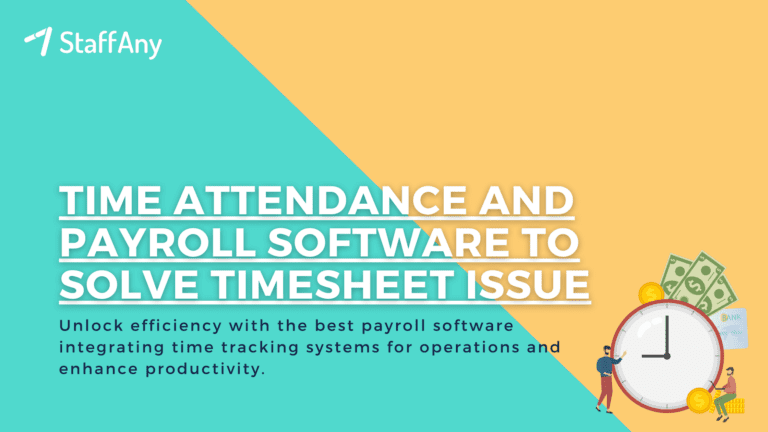Employee scheduling is an essential aspect of any business that relies on a workforce. However, scheduling employees can be a complex and time-consuming task, especially for managers who have multiple responsibilities. A poorly managed employee schedule can lead to a range of issues, including decreased productivity, employee burnout, and increased turnover rates.
In this article, we will discuss ten critical employee scheduling problems that businesses commonly face and provide solutions to overcome them. By addressing these scheduling challenges, businesses can create a more productive and efficient work environment that benefits both the business and its employees.
What is the Employee Scheduling Problem?

Staff scheduling problem, often referred to as employee scheduling or workforce scheduling, is a complex optimization problem that businesses and organizations face when assigning work shifts or schedules to their employees.
The goal of staff scheduling is to create efficient and fair schedules that meet operational requirements while considering various constraints and objectives. This problem is particularly important in industries where shifts, such as retail, healthcare, manufacturing, and hospitality, are essential for daily operations.
Main Pillars of Employee Scheduling Problems
The staff scheduling problem typically involves the following key elements:
1. Employees
There is a group of employees with different skills, availability, and preferences.
2. Shifts
There are different types of shifts (e.g., day, night, morning, evening) with specific start and end times.
3. Constraints
Various constraints must be taken into account, such as labor laws, union rules, employee preferences, and labor regulations. These constraints can include maximum and minimum working hours, rest periods between shifts, skill requirements for specific shifts, and more.
4. Objectives
The scheduling process aims to optimize certain objectives, such as minimizing labor costs, maximizing employee satisfaction, ensuring fair distribution of shifts, and meeting operational demands.
Read more: How to Schedule Staff Effectively?
Sub-problems in Scheduling Issues
The staff scheduling problem can be further categorized into various subproblems, including:
1. Shift Scheduling
Determining which employees should work which shifts and on which days to meet staffing requirements.
2. Roster Scheduling
Creating schedules for an extended period, such as a week or a month, while considering long-term constraints.
3. Task Assignment
Assigning specific tasks or roles to employees based on their skills and qualifications.
4. Dynamic Scheduling
Adjusting schedules in real-time to accommodate unexpected changes, such as employee call-offs or increased demand.
To solve the staff scheduling problem, businesses and organizations often use a combination of manual scheduling methods, spreadsheets, or specialized software.
In recent years, advanced algorithms and artificial intelligence techniques have been applied to automate and optimize staff scheduling, improving efficiency and employee satisfaction while reducing labor costs.
These algorithms consider multiple factors simultaneously and can quickly generate optimal or near-optimal schedules, taking into account the complex constraints and objectives associated with staff scheduling.
12 Crucial Employee Scheduling Problems and How to Solve Them
Effective employee scheduling is a key aspect of any business that relies on a workforce. However, scheduling employees can be a difficult task, especially for managers who have to juggle multiple responsibilities. Here are ten of the most common employee scheduling problems you could face and how to solve them:
1. Lack of Flexibility
One of the most significant scheduling problems businesses face is the lack of flexibility in their scheduling process. Employees may have varying schedules or personal commitments that make it difficult to work specific hours.
Additionally, unexpected situations, such as illnesses or family emergencies, can require last-minute changes to the schedule. A lack of flexibility can lead to decreased employee satisfaction and increased absenteeism.
To solve this problem, businesses can implement flexible scheduling policies that allow employees to work variable hours or switch shifts with their colleagues. Businesses can also utilise employee scheduling software that allows for easy schedule changes and updates in real-time.
By providing flexibility in the scheduling process, businesses can accommodate employees’ work life balance and create a more satisfied and engaged workforce.
2. Over or Understaffing
Another critical scheduling problem is over or understaffing. Overstaffing can lead to wasted resources and increased labour costs, while understaffing can lead to decreased productivity and employee burnout. Finding the right balance can be challenging, especially for businesses that have fluctuating demand.
To solve this problem, businesses can utilise forecasting and employee scheduling app to predict demand and schedule enough employees accordingly. This can help businesses avoid over or understaffing and optimise labour costs.
Additionally, businesses can use employee scheduling software to monitor employee availability and prevent scheduling conflicts. By ensuring that the right number of employees are scheduled at the right time, businesses can improve productivity, reduce costs, and create a more satisfied workforce.
3. Manual Scheduling
Many businesses still rely on manual scheduling processes, such as spreadsheets or paper schedules. However, manual scheduling can be time-consuming, error-prone, and inefficient. Additionally, manual scheduling can make it challenging to make last-minute changes or updates to the schedule.
To solve this problem, businesses can implement employee scheduling software that automates the scheduling process. This software can automatically generate schedules based on employee availability, skill sets, and labour laws.
It can also allow for real-time updates and changes, reducing the need for manual intervention. By automating the scheduling process, businesses can save time, reduce errors, and create a more efficient and effective scheduling process.
Read more: How to Establish Effective Workplace Communication
4. Inefficient Communication
Inefficient communication is another critical scheduling problem that can lead to confusion and errors in the scheduling process. Managers may struggle to communicate schedule changes or updates to employees, leading to missed shifts or scheduling conflicts.
To solve this problem, businesses can implement employee scheduling software that allows for easy and efficient communication between managers and employees. This software can send notifications and reminders to employees regarding their schedules, as well as allow for real-time communication between employees and managers.
By improving communication, businesses can reduce scheduling errors, improve productivity, and create a more engaged workforce.
5. Lack of Accountability
A lack of accountability is another scheduling problem that can lead to missed shifts or scheduling conflicts. When employees do not feel accountable for their schedules, they may be more likely to miss shifts or fail to show up for work.
To solve this problem, businesses can implement employee scheduling software that allows for easy tracking of employee attendance and performance. Additionally, businesses can set clear expectations for attendance and punctuality and enforce consequences for missed shifts or scheduling conflicts.
By creating a culture of accountability, businesses can improve employee attendance and reduce scheduling errors.
6. Overtime Costs
Overtime costs can be a significant expense for businesses, especially those that have fluctuating demand or unexpected scheduling needs. Overtime can also lead to employee burnout and decreased productivity.
To solve this problem, businesses can use forecasting and scheduling software to predict demand and schedule employees accordingly. Additionally, businesses can implement overtime policies that limit the number of hours employees can work in a given week or pay period.
By reducing overtime costs, businesses can improve labour costs and create a more efficient scheduling process.
Read more: 8 Staff Schedule Management Tips for Business Owners
7. Poor Visibility in Scheduling Data
Without visibility into scheduling data, businesses may struggle to make informed decisions about scheduling and labour costs. Managers may not have access to real-time data or may have difficulty analysing data trends.
To solve this problem, businesses can implement employee scheduling software that provides real-time visibility into scheduling data. This software can provide managers with up-to-date data on labour costs, employee availability, and scheduling trends.
Additionally, businesses can use this data to make informed decisions about scheduling, labour costs, and overall workforce management.
8. Compliance Issues
Compliance with labour laws can be a significant challenge for businesses, especially those that operate in multiple jurisdictions. Failure to comply with labour laws can result in fines, penalties, and legal action.
To solve this problem, businesses can implement employee scheduling software that automates compliance with labour laws. This software can ensure that schedules comply with minimum wage laws, overtime laws, and other labour regulations.
Additionally, businesses can use this software to track employee hours and ensure compliance with record-keeping requirements. By automating compliance, businesses can reduce the risk of legal action and ensure that employees are treated fairly and in compliance with labour laws.
9. On-Call Scheduling
Customer demand can be unpredictable, leading some companies to opt for having employees on standby or on call. This approach entails having employees contact their workplace before their shifts commence to ascertain if their presence is required.
In instances where it is anticipated that the shift will be uneventful, employees may be informed not to report for work during their designated shifts. However, this practice tends to be disheartening for employees since it hampers their ability to make plans. Additionally, there is a growing trend among regulators to discourage this concept.
Resolving the challenges associated with on-call scheduling is feasible. Managers require access to historical data to comprehend past patterns and make informed scheduling forecasts. Job scheduling software is a viable solution for addressing these issues, as it obviates the need for on-call scheduling and enhances employee satisfaction.
10. Employee Turnover
While “quiet quitting” is gaining attention in the workplace, what truly concerns small business owners is the actual departure of their employees. Employee turnover has the potential to be highly detrimental to a business.
Even at a “tolerable” level, it can adversely affect employee morale and team effectiveness. In the current environment of elevated turnover rates, it can significantly harm customer satisfaction and damage a company’s reputation.
Selecting the appropriate personnel is crucial. Familiarize yourself with the characteristics of an ideal candidate and enhance your interviewing methods to effectively evaluate potential employees. The ideal employee should not only possess the requisite job qualifications but also align with the team dynamics and the company’s culture.
Read more: Employee Turnover Rate: Measuring and Reducing
11. Limited Access to Scheduling Data
Without access to scheduling data, employees may struggle to manage their schedules or make informed decisions about their availability. Additionally, limited access to scheduling data can lead to scheduling conflicts or missed shifts.
To solve this problem, businesses can implement employee scheduling software that provides employees with real-time access to scheduling data. This software can allow employees to view their schedules, request time off, and swap shifts with their colleagues.
This software can also send notifications and reminders to employees regarding their schedules, reducing the risk of missed shifts or scheduling conflicts.
12. Lack of Integration with Other Systems
Many businesses use multiple systems to manage their workforce, such as payroll, time and attendance, and HR systems. However, these systems may not be integrated with the scheduling system, leading to inefficiencies and errors in the scheduling process.
To solve this problem, businesses can implement employee scheduling software that integrates with other workforce management systems. This software can ensure that scheduling data is synced across all systems, reducing the risk of errors and inefficiencies.
Additionally, integration can improve data visibility and provide managers with a more holistic view of their workforce.
Read more: 13 Employee Retention Programs to Retain Your Top Talents
StaffAny: Your One-Stop Solution
With so many employee scheduling problems to overcome, businesses need a comprehensive solution that can address all their scheduling needs. StaffAny is an all-in-one employee shift scheduling software that provides a range of features to streamline scheduling, such as:
Real-Time Availabilities
Schedule with One Click
Improve Visibility of Labor Costs During Scheduling
Effortlessly Comply with Labour Laws
Support for One Outlet or 100
Real-Time Schedule Updates
StaffAny is a scalable solution that can accommodate businesses of all sizes, from small startups to large enterprises. With StaffAny, businesses can create flexible, efficient schedules that keep employees happy and productive. Try StaffAny today and see how easy employee scheduling can be!











